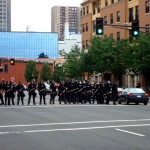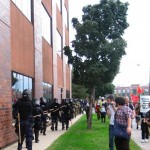I teach at a public university where legendary tales still circulate about the school’s early years as an experimental college. I once did an inquiry into that epoch. The puzzle, I discovered, centered on the institution’s origins: Did the Minnesota Legislature actually authorize such a radical experiment? According to Andrew Abbott, “We learn that switching questions is a powerful heuristic move.” Instead of asking why this occurred, I asked how it came to be. As a sociologist, that move seems be have been a fatal faux pas.
I wrote that case study as a historical narrative. Readers who were generalists found the tale compelling and self-explanatory. Sociologists? Not so much. While most disciplinary colleagues praised the storytelling, nearly all found the study lacking in explanatory power. Even though I was examining an anomaly, they faulted the inquiry for a lack of theoretical “payoff.” They at least wanted the story to be a “deviant” case of something, anything.
I acknowledge that this tepid response from professional sociologists may have been due to the paper’s lack of merit. Nevertheless, this experience has generated some methodological observations that may have value, regardless the article’s worth. To give the reader a quick and dirty synopsis of the narrative’s plot, here is the abstract for “Genesis of a Utopian College.”
Before its doors even opened in 1971, a renowned educational leader had proclaimed an obscure state college in Minnesota to be “perhaps the most innovative institution of higher education in the United States.” This historical case study seeks to explain how possibly this could have happened? Paradoxically, the genesis of this utopian college was, in fact, only the consequence of a long process of politics as usual. The narrative traces a series of actions that established this utopian college, particularly highlighting a successful process of acquiring and exercising power in turf wars at the state legislature and in the Byzantine politics of higher education’s bureaucracy. The plot’s denouement features one past and one future vice president of the United States intervening as midwives for the new college. The eventual establishment of the school led to an outcome that the state’s legislature and higher education bureaucracy had neither intended nor anticipated.
When seeking to explain events like this, most sociologists abhor anomalies and aberrations. My colleagues typically ask, “Why did this thing happen?” They then proceed to seek a categorical generalization that applies to all similar cases. Anomalies and aberrations need not apply. Andrew Abbott uses a hypothetical vignette to capture this “Standard Model.” Sometime in the future, writes Abbott in Time Matters, a scholar is struggling to reconstruct how sociologists thought in the last half of the twentieth century:
The people who called themselves sociologists believed that society looked the way it did because social forces and properties did things to other social forces and properties. . . . Sociologists called these forces and properties “variables.” Hypothesizing which of these variables affected which others was called “variable analysis.” . . . In this view, narratives of human actions might provide “mechanisms” that justified proposing a model, but what made social science science was the discovering of these “causal relationships.” (2001:97)
I sent an early draft of this article to a prominent sociologist of higher education. She graciously read and commented on the work. Not surprisingly, she wrote that while the paper was “an interesting start in writing an analytical history of Metro State. . . . I would suggest more analytical attention to the social, economic and political environment for the founding and continuing development of the college.” She also sent along a monograph that she had written about another educational organization, “which delineates some of the social conditions that might have been relevant to the founding and development of MMSC” (Personal correspondence).
What was her point? My paper lacked theoretical generalization. For her, “analytical” and “social conditions’ were code words for causal explanation. She was expecting me to “explain” the genesis of Metropolitan State by showing that “because a certain enabling condition was in fact in place, what happened was quite within the realm of possibility and need not have occasioned surprise.” (Dray, Philosophy and History 2nd ed., 1993:27).
What might be some of the social conditions that would give my Metropolitan State narrative a more analytical flavor? The list would include the demographics of the baby boom generation, the evolution of a credential society, the student revolt of the 1960s, the progressive nature of Minnesota politics, the post-World War II affluent society, the rise of mass education, and the development of the multiversity. The conditions I list above certainly had contextual relevance for my case study, but a dubious search for a casual condition or independent variable among them provides little explanatory power for this surprising occurrence. As the historian John Lewis Gaddis once quipped, “Aren’t all variables dependent on other variables?”
Her comments led me to set aside the manuscript for several years. In “Genesis of a Utopian College,” I had written a narrative history of an unanticipated outcome. The philosopher M.C. Lemon captures the essence of her critique: “The accusation—for such it is—against narrative history is that it is naïve.” Most social scientists, philosophers, and even some historians argue that the narrative is non-explanatory of its subject matter:
Consequently, we do not even envisage the possibility of a form of explanation other than causal. In fact, a non-causal form of explanation appears to us to be anomalous, even a contradiction. . . . The narrative, on the other hand, refers to the dialectic of structure and agency and asks: ‘What situation and series of actions resulted in the occurrence of E?’ (Mahajan, Explanation and Understanding in the Human Sciences,1992:95
I was seeking just such an explanation for this aberration. That this new college became a radical experiment was indeed unexpected. The question I sought to answer is, “How could this outcome have happened?” The historian Richard Evans concisely states my rationale: “Consequences are often more important that causes.”
Howard S. Becker provides a roadmap of my research strategy:
Assume that whatever you want to study has, not causes, but a history, a story, a narrative . . . On this view, we understand the occurrence of events by learning the steps in the process by which they came to happen, rather than by learning the conditions that made their existence necessary. . . . This is not just a matter of saying the right words, “process” instead of “cause.” It implies a different way of working. (Tricks of the Trade,1998:61)
Politics is the processes of acquiring and exercising power in order to attain public goods. Legislative and bureaucratic politics are embedded in structural and temporal contexts that constraint the actions of actors. This case study examines how a masterful bureaucratic politician acquires and exercises power in this contentious world of state politics. A three-year campaign for a new state college was just one acquisition in his larger quest for power. What needs explanation is how this particular college metamorphosed into a unique utopian experiment.
No one in 1968 could have imagined that Metropolitan State would become a utopian college. “What situation and series of actions” produced this result? How can the plotting of such a succession of events satisfy the demand that a narrative provide an explanation of its subject matter? The maverick economist, Albert O. Hirschman, offers a powerful warrant for narrative explanations.
In “The Search for Paradigms as a Hindrance to Understanding,” Hirschman targets “the tendency toward compulsive and mindless theorizing.” He argues that “an impatience for theoretical formulation leads to serious pitfalls.” To make his point, he contrasts two books about Latin America, both written by young North American scholars. The most important difference he finds is in the cognitive styles of the two authors.
Within the first few pages of his book Payne presents us triumphantly with the key to the full and complete understanding of the Colombian political system. The rest of the book is a demonstration that the key indeed unlocks all conceivable doors of Colombian political life, past, present, and future. Womack, on the other hand, abjures any pretense at full understanding right in the preface, where he says that his book “is not analysis but a story because the truth of the revolution in Morelos is in the feeling of it which I could not convey through defining its factors but only through telling of it.” “The analysis that I could do,” he continues, “and that I thought pertinent I have tried to weave into the narrative, so that it would issue at the moment right for understanding it.” (Interpretative Social Science: A Second Look, 1987:179)
The Metropolitan State narrative is neither naïve nor is it non-explanatory; it is simply incommensurate with the “Standard Model” of sociology. Narrative and causal explanatory models reflect two divergent cognitive styles. Variable analysis, no matter how nuanced, is incapable of adequately explaining the contingent nature of improbable and non-repeatable outcomes. It was only in the telling of the tale that I could make intelligible the process of how a unique constellation of events made this genesis possible. A thick description of each specific situation and the ensuing series of actions provides the analytic rigor required to explain how possibly this anomaly occurred.


